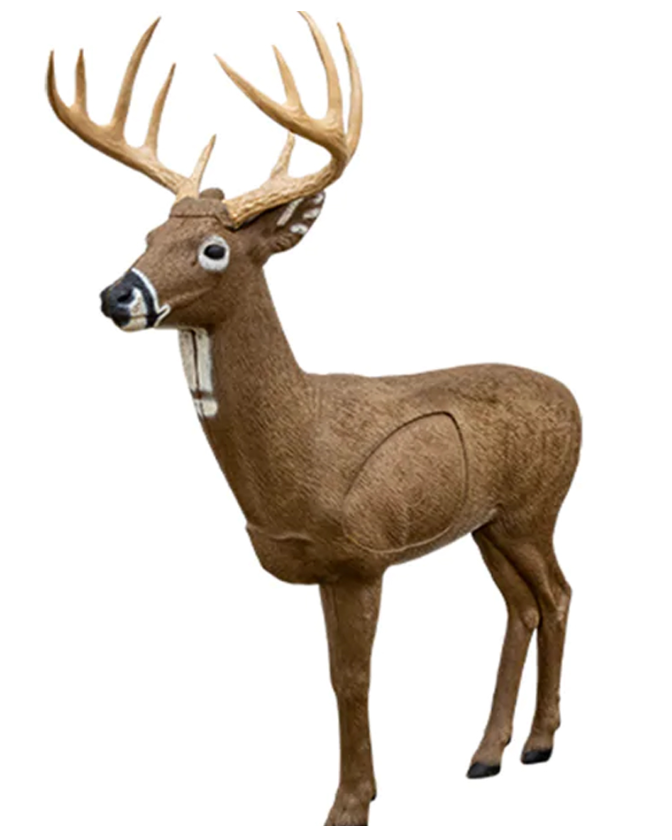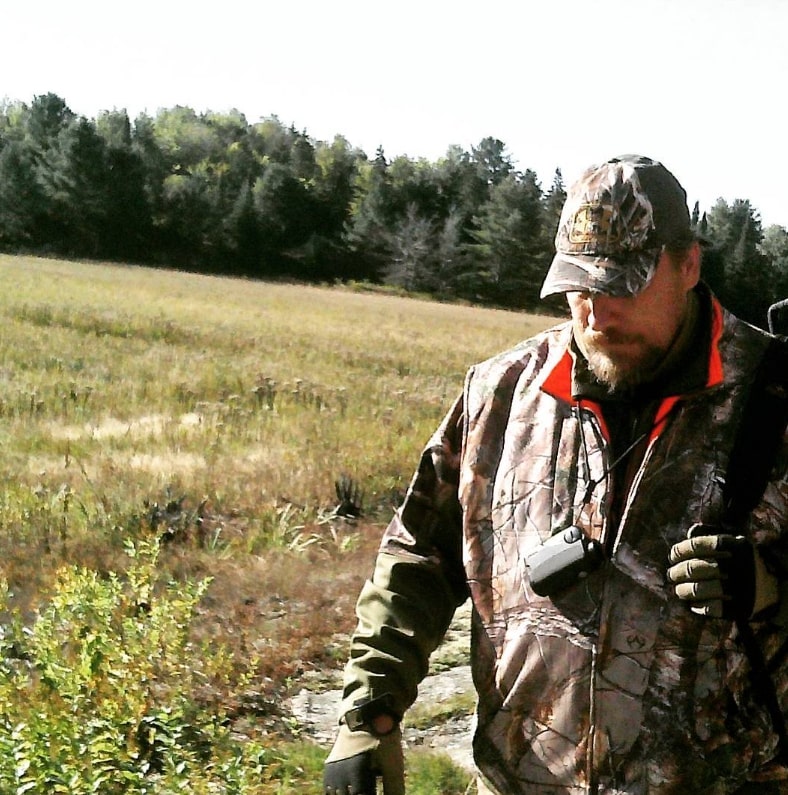Big Game Hunting Targets


A Comprehensive Guide for Avid Outdoorsmen

Introduction
In this article, we’ll embark on a journey through the wilderness, discussing the essence of big game hunting, understanding the targets, and equipping ourselves for success. Whether you’re a seasoned hunter or a novice eager to step into the field, this guide is your compass for an unforgettable adventure.
Big game hunting is not just a sport; it’s a way of life for avid outdoorsmen, especially those focused on whitetail deer hunting. As we delve into the world of big game, we’ll explore the intricacies of this exhilarating pursuit, offering insights into the diverse targets that captivate hunters across the globe.
Understanding Big Game
What Defines Big Game?
Big game, in the realm of hunting, goes beyond mere size. It encompasses species that present a significant challenge to hunters, both in terms of their physical attributes and their elusive nature. These are animals that demand a combination of skill, patience, and strategic thinking to successfully pursue. It’s not just about the size of the trophy; it’s about the journey, the pursuit, and the connection forged between the hunter and the magnificent creatures that roam the wild.
In the diverse world of big game, hunters often find themselves captivated by the sheer variety of species. From the majestic elk with their impressive antlers to the cunning and elusive whitetail deer, each target offers a unique set of challenges. Understanding what makes an animal “big game” involves recognizing the complexities of their behavior, habitats, and the ecosystems they inhabit.
Popular Big Game Species
The Iconic Whitetail Deer
Whitetail deer, a staple for many avid outdoorsmen, symbolize the essence of big game hunting. Their keen senses, unpredictable movements, and adaptability to various environments make them a challenging and rewarding target. Exploring the intricacies of whitetail deer behavior, such as rutting patterns and feeding habits, becomes essential for a successful hunt.
The Majestic Elk
Elk, known for their grandeur and commanding presence, are another coveted big game species. Understanding the vast habitats they inhabit, their migration patterns, and the significance of their vocalizations becomes paramount for hunters seeking an encounter with these majestic creatures.
Diverse Targets Beyond the Basics
Big game hunting isn’t confined to just deer and elk. Hunters might set their sights on bears, moose, or even mountain lions, each presenting its own set of challenges and requiring a distinct approach. Exploring the nuances of these diverse targets adds depth to the hunting experience, broadening the understanding of big game as a whole.
The Challenge and the Connection
What defines big game ultimately extends beyond the physical characteristics of the animals. It’s about the challenge of the pursuit, the harmony with nature, and the responsibility that comes with being a steward of the wilderness. The thrill of understanding and connecting with these creatures in their natural habitats elevates big game hunting from a recreational activity to a profound, immersive experience—one that leaves an indelible mark on the hunter’s soul.

Choosing the Right Gear
Hunting success hinges on the gear you choose. From firearms to optics and clothing, we’ll delve into the essentials every hunter should consider for a fruitful expedition.
Firearms and Ammunition
Selecting the appropriate firearm and ammunition is a critical decision that can significantly impact the outcome of your big game hunt. The choice depends on the specific species you’re targeting and the environment in which you’ll be hunting. For instance, a lightweight and maneuverable rifle may be ideal for stalking whitetail deer in dense woods, while a more powerful and long-range option might be necessary for elk hunting in open landscapes.
Understanding ballistics and choosing the right caliber is equally crucial. It’s not just about power; it’s about achieving the right balance for a clean and humane kill. A responsible hunter considers factors like shot placement, recoil management, and ammunition performance to ensure an ethical and effective harvest.
Optics and Scopes
Quality optics can make the difference between a successful hunt and a missed opportunity. Investing in high-grade binoculars and a reliable scope enhances your ability to spot game from a distance, providing a clearer and more detailed view. Consider factors such as magnification, lens quality, and reticle type based on your hunting style and the terrain you’ll be navigating.
In the world of big game hunting, where targets can be elusive and camouflage themselves seamlessly, a good scope can be the hunter’s best ally. It not only aids in target identification but also ensures a precise shot placement, minimizing the chances of a wounded animal.
Clothing and Footwear
Choosing the right clothing and footwear is often underestimated but plays a crucial role in the success of a hunt. The wilderness presents various challenges, from unpredictable weather to rough terrain, and being adequately prepared can make a significant difference.
Opt for clothing that provides effective camouflage, taking into account the natural surroundings of your hunting area. Additionally, prioritize garments that offer weather protection, ensuring you stay comfortable in rain, snow, or extreme temperatures. Quality waterproof and insulated boots are essential, providing the necessary support and protection for long hours of traversing diverse landscapes.
Selecting gear that aligns with your specific hunting conditions and preferences enhances not only your comfort but also your ability to move quietly and stay concealed, increasing the likelihood of a successful and enjoyable hunting experience. Remember, choosing the right gear is not just about functionality; it’s about creating a harmonious synergy between the hunter and the environment, ensuring a memorable and ethical pursuit of big game.




Scouting Techniques
Utilizing Trail Cameras
In the realm of big game hunting, knowledge is power, and trail cameras have become an invaluable tool for gaining insights into wildlife patterns. Strategically placing trail cameras in key locations allows hunters to observe the movement and behavior of game species without directly impacting their habitat.
When utilizing trail cameras, it’s essential to consider factors such as placement and timing. Positioning cameras near natural features like water sources, food plots, or known travel routes increases the likelihood of capturing valuable footage. Moreover, understanding the seasonal behaviors of the target species helps in determining the most effective times to deploy and retrieve trail cameras.
The information collected from trail cameras goes beyond mere sightings. It provides details on the size and age of the animals, their preferred travel routes, and the times they are most active. Armed with this knowledge, hunters can strategically plan their approach, increasing the chances of a successful and ethical harvest.
Reading Tracks and Signs
While trail cameras offer a technological edge, mastering the ancient art of reading tracks and signs is an essential skill for any proficient hunter. Tracks tell a story—the size, depth, and spacing reveal the type of animal and its gait. Analyzing tracks alongside other signs, such as droppings, rubs on trees, and bedding areas, creates a comprehensive narrative of the wildlife’s activities in the area.
Tracking involves a keen eye for detail and an understanding of the specific characteristics of each species. For example, deciphering the difference between a whitetail deer track and an elk track can be crucial for tailoring your approach to the target species. Additionally, paying attention to the freshness of tracks provides insights into how recently the animal passed through the area.
Seasoned hunters often describe tracking as an art form—a dance between the tracker and the wild. It’s not just about following footprints; it’s about interpreting the language of the land and understanding the nuances of the game’s behavior. By honing these skills, hunters gain a deeper connection to the environment and an increased likelihood of a successful hunt.
Incorporating both technological advancements and age-old tracking techniques, scouting becomes a dynamic and multifaceted process. It’s about utilizing the best of both worlds to understand the rhythm of the wilderness, ensuring that each hunt is not just a pursuit but a harmonious interaction with the natural world.
Strategies for Whitetail Deer Hunting
The Whitetail’s Behavior
Whitetail deer, with their elusive nature and keen senses, pose a thrilling challenge for hunters. Understanding the behavior of these majestic creatures is crucial for devising effective strategies. Seasoned hunters often emphasize the significance of studying the whitetail’s daily and seasonal patterns.
Rutting Season Insights
The rut, or mating season, is a prime time for whitetail deer hunting. Bucks become more active, marking territories and seeking mates. Understanding the timing and signs of the rut allows hunters to capitalize on the increased movement of deer. Grunts and rattling techniques mimicking bucks in combat can attract curious bucks, presenting opportunities for a well-placed shot.
Feeding Patterns
Whitetail deer are known for their selective and consistent feeding habits. Identifying preferred food sources, such as specific types of vegetation or agricultural crops, enables hunters to strategically position themselves. Establishing hunting spots near these feeding areas during the early morning or late afternoon can increase the likelihood of encountering deer.
Bedding Areas
Knowing where whitetails rest during the day is as crucial as understanding their feeding patterns. Bedding areas provide insight into the deer’s preferred cover and shelter. Setting up along travel routes between bedding and feeding areas increases the chances of intercepting deer as they move throughout the day.
Best Times for Whitetail Hunting
Dawn and Dusk Magic
Experienced whitetail hunters often swear by the magic hours of dawn and dusk. During these low-light periods, deer are more active, feeling a sense of security in the shadows. Stalking or setting up in strategic locations during these times can offer prime opportunities for a successful hunt.
Weather Considerations
Weather plays a significant role in whitetail behavior. Overcast days or periods of light rain may encourage deer to move during daylight hours, providing advantageous hunting conditions. Additionally, paying attention to wind direction is crucial, as deer rely heavily on their sense of smell for detecting predators.
Moon Phases
Some hunters believe that moon phases influence deer movement. While opinions vary, it’s worth considering the potential impact of a full moon on deer activity. During well-lit nights, deer may feed more at night, altering their daytime patterns.
Incorporating these strategies into your whitetail deer hunting approach requires a blend of patience, knowledge, and adaptability. It’s about reading the subtle cues of the environment, understanding the language of the deer, and immersing yourself in the ebb and flow of nature. Successful whitetail hunting isn’t just about pursuing a trophy; it’s about embracing the art and science of the chase, creating an unforgettable connection with one of the most elusive game species in the wild.
Understanding Elk Behavior for a Successful Hunt
Elk Habitat and Migration
To embark on a successful elk hunt, one must delve into the intricacies of elk behavior, starting with their preferred habitats and migration patterns. Elk are highly adaptable creatures, inhabiting a range of ecosystems from mountainous terrains to dense forests. Understanding the specific characteristics of these environments is crucial for pinpointing prime elk locations.
Mountainous Havens
Elk often seek refuge in mountainous regions, drawn to the ample forage and rugged landscapes that provide natural protection. Identifying key features like high-altitude meadows, dense thickets, and water sources within these mountains aids in narrowing down potential hunting spots.
Seasonal Migration
Elk exhibit seasonal migration patterns driven by factors such as weather, food availability, and mating instincts. During warmer months, they may move to higher elevations in search of cooler temperatures and abundant vegetation. As the weather turns colder, elk migrate to lower elevations, seeking shelter and sustenance. Knowing these migration routes helps hunters strategize their approach based on the time of year.
Key Elk Vocalizations
Communication is integral to elk behavior, and understanding their vocalizations is akin to unlocking a hidden language. Elk produce various sounds, each serving a distinct purpose in their social structure.
Bugles: The Call of the Wild
The bugle is arguably the most iconic elk vocalization, especially during the rut. Bulls emit bugles to assert dominance, attract mates, and communicate with other members of their herd. Recognizing the nuances of bugling—whether it’s a challenge bugle or a location bugle—can guide hunters in deciphering the elk’s intentions and positioning themselves strategically.
Cow Calls: The Language of Mating
Cow calls, mimicking the sounds female elk make, are valuable tools for hunters. During the rut, bulls actively seek out receptive cows. Using cow calls can draw curious bulls closer, presenting an ideal opportunity for a well-placed shot.
Mastering the art of elk vocalizations is akin to conversing with these majestic creatures. It involves not only recognizing the calls but responding appropriately. Elk hunting becomes a symphony of sounds—a dance of bugles and cow calls that connects the hunter with the pulse of the wilderness.
Understanding elk behavior is an ongoing process, a dynamic journey of observation, adaptation, and respect for the natural world. It’s about immersing oneself in the intricacies of elk life, decoding their movements, and anticipating their responses. Armed with this knowledge, hunters can transform their pursuit into a harmonious and successful elk hunting experience.
Challenges and Ethical Considerations
Big game hunting is a pursuit that intertwines challenges with a profound sense of responsibility. As avid outdoorsmen set out into the wilderness, they encounter hurdles that go beyond the physical aspects of the hunt, touching upon ethical considerations that shape the very fabric of the sport.
Conservation and Sustainability
One of the foremost challenges in big game hunting is maintaining a delicate balance between conservation and the thrill of the chase. Ethical hunters recognize the importance of preserving wildlife populations and their habitats. Engaging in sustainable practices involves understanding local ecosystems, adhering to hunting quotas, and supporting conservation initiatives.
Stewardship of Wildlife
Hunters often find themselves in the role of stewards for wildlife. Contributing to conservation efforts through financial support, habitat restoration, and participation in research programs becomes not just a responsibility but a commitment to ensuring the longevity of the species they pursue.
Sustainable Harvesting
Balancing the desire for a successful harvest with the need for sustainable practices is a perpetual challenge. Hunters must be mindful of population dynamics, ensuring that their actions do not disrupt the delicate equilibrium of the ecosystem. Responsible harvesting involves selecting mature animals, respecting hunting regulations, and acknowledging the ecological impact of each hunt.
Adapting to Environmental Changes
The great outdoors is not static; it evolves with time, presenting hunters with the challenge of adapting to environmental changes. Climate fluctuations, habitat alterations, and human influence contribute to a dynamic landscape that demands flexibility and resilience.
Impact of Climate Change
Climate change poses a significant threat to wildlife habitats. Hunters witness shifts in animal behavior, altered migration patterns, and changes in vegetation that impact the availability of food sources. Adapting to these changes involves staying informed, advocating for sustainable practices, and actively participating in initiatives that address environmental concerns.
Human-Wildlife Conflict
As human populations expand, the interface between civilization and wilderness becomes a zone of potential conflict. Ethical hunters navigate this challenge by promoting coexistence, supporting measures to mitigate conflicts, and fostering a harmonious relationship between humans and wildlife.
The Ethical Hunter’s Code
Beyond the challenges lies a profound ethical responsibility that shapes the ethos of big game hunting. Ethical hunters adhere to a code that extends beyond legal requirements, encompassing principles that reflect a deep respect for nature and its inhabitants.
Fair Chase
Fair chase is a cornerstone of ethical hunting. It involves pursuing game in a manner that allows them a reasonable chance to escape, respecting the inherent instincts and behaviors of the animals. This principle ensures that the hunt is a test of skill and knowledge rather than an unfair advantage.
Humane Harvest
The ethical hunter prioritizes humane harvesting, aiming for quick, clean kills to minimize suffering. This involves precision in shot placement, understanding the anatomy of the target species, and employing the right equipment for a swift and ethical harvest.
Respect for Regulations
Ethical hunters are diligent in adhering to hunting regulations and laws. This extends to obtaining proper permits, respecting seasonal restrictions, and reporting harvests accurately. Compliance ensures the sustainability of hunting practices and contributes to the overall welfare of wildlife populations.
In navigating the challenges and ethical considerations of big game hunting, individuals transform from mere hunters into stewards of the wilderness. The pursuit becomes a dynamic interplay of skill, knowledge, and ethical principles—a journey that fosters a profound connection with nature and a commitment to preserving the delicate balance of the wild.
The Thrill of the Hunt: Personal Experiences
In the heart of the wilderness, where the crisp air carries the scent of pine and the rustle of leaves heralds the presence of unseen creatures, the thrill of the hunt becomes an indescribable experience that transcends the physical pursuit of game. It is a journey of self-discovery, resilience, and a deep connection with nature that avid outdoorsmen cherish in the tapestry of their personal hunting narratives.
Memorable Hunting Stories
Every hunter carries with them a collection of memorable stories—vivid recollections of moments that define their pursuit of big game. These stories are more than mere recounts of successful harvests; they encapsulate the essence of the hunt, embodying the challenges faced, the unexpected twists, and the sheer exhilaration of being in the wild.
The Elusive Trophy
A seasoned hunter might share the tale of the elusive trophy, the one that required not just skill but an unwavering patience to track and outsmart. It’s a story of persistence, where the thrill wasn’t just in the kill, but in the intricate dance between the hunter and the hunted.
Adrenaline in the Unknown
For some, the thrill lies in the unknown—the unexpected encounters that quicken the pulse and leave an indelible mark on the hunter’s memory. A sudden rustle in the bushes, a majestic silhouette against the skyline—these are the moments that embody the unpredictable beauty of the wilderness.
Lessons Learned in the Field
The thrill of the hunt extends beyond the adrenaline-pumping moments to the invaluable lessons learned in the field. It’s a classroom where nature is the teacher, and each experience imparts wisdom that goes beyond the tangible harvest.
Patience as a Virtue
Many hunters recount stories that emphasize the virtue of patience. Hours spent in a blind or stalking through challenging terrain teach the art of waiting—a skill that extends beyond the hunt and into the fabric of everyday life.
Resilience in the Face of Challenges
The wild is unpredictable, and personal hunting experiences often involve overcoming unforeseen challenges. Whether it’s navigating treacherous terrain, enduring adverse weather, or adapting to the unpredictability of wildlife behavior, these challenges forge resilience and mental fortitude.
Crafting a Connection with Nature
Beyond the trophies and tales of triumph, the thrill of the hunt is about crafting a profound connection with nature. It’s in the silent moments before dawn, where the world awakens, and the hunter becomes an integral part of the wilderness.
Silence Speaks Volumes
Experiences in the field underscore the value of silence—an unspoken communion with the natural world. In these quiet moments, hunters feel the pulse of the environment, attuning themselves to the language of the wind, the calls of distant creatures, and the rustle of leaves underfoot.
A Symphony of Sounds and Scents
The thrill is heightened by the symphony of sounds—the haunting bugle of an elk echoing through the mountains, the rhythmic drumming of a grouse, or the distant howl of a wolf. Coupled with the earthy scents of the forest, these sensory experiences become an integral part of the hunter’s personal journey.
In recounting personal hunting experiences, the thrill is not just in reliving the pursuit but in sharing the transformative moments that shape the hunter’s perspective. Each story becomes a testament to the multifaceted allure of big game hunting—a pursuit that transcends sport and becomes a rich tapestry woven with threads of adventure, challenge, and the enduring connection between the hunter and the untamed wild.
Preparing and Processing the Harvest
The culmination of a successful big game hunt is not just the harvest itself but the artful process of preparing and transforming the bounty into nourishment. For the avid outdoorsman, this phase of the journey represents a profound connection with the land, an extension of the hunt that involves skill, respect, and a celebration of the natural cycle.
Field Dressing and Butchering
Once the harvest is secured, the meticulous process of field dressing and butchering commences. It’s a skill that goes beyond the mere act of dressing an animal; it’s a dance with anatomy, precision, and an understanding of the importance of preserving the quality of the meat.
Respectful Harvesting
Ethical hunters approach field dressing with a deep respect for the animal. Swift and humane practices not only minimize stress on the harvested animal but also contribute to the quality of the meat. Knowing the anatomy and employing proper techniques ensure an efficient and respectful harvest.
Quick and Efficient Processing
The field dressing is swiftly followed by butchering, where the animal is transformed from a majestic creature of the wild into carefully portioned cuts. A skilled hand ensures minimal waste and maximum utilization of the harvest. The choice of cuts—whether steaks, roasts, or ground meat—depends on the preferences of the hunter and their culinary aspirations.
Tips for Proper Meat Handling
Ensuring the quality and freshness of the meat is paramount in the hunter’s journey. Proper meat handling techniques not only preserve the integrity of the harvest but also contribute to the culinary success that follows.
Cooling and Aging
Rapidly cooling the meat is crucial to prevent spoilage. Many hunters practice aging the meat, allowing it to rest in controlled conditions for a period. This process enhances the tenderness and flavor of the meat, elevating the dining experience.
Packaging for Preservation
Proper packaging, whether through vacuum-sealing or traditional wrapping, protects the meat from freezer burn and oxidation. Each carefully wrapped package becomes a promise of future meals—a testament to the harvest’s sustenance and the skills of the hunter.
The Culinary Art of Big Game
The journey from harvest to plate is a culinary adventure that beckons the hunter to explore flavors, techniques, and the art of transforming raw meat into delectable dishes.
Culinary Creativity
In the kitchen, the hunter becomes a culinary artist, experimenting with recipes that showcase the richness of the game. Whether it’s a succulent venison roast, a hearty elk stew, or savory game sausages, each dish is a testament to the diverse flavors that the wild provides.
Sharing the Bounty
The joy of the harvest extends beyond personal consumption. Many hunters find gratification in sharing their bounty with friends and family, fostering a sense of community and appreciation for the sustenance that nature provides.
In preparing and processing the harvest, the hunter not only engages in a practical aspect of the journey but also becomes a steward of the land. The respect shown to the animal, the skill in harvesting, and the artistry in culinary creation all intertwine to form a narrative of sustainability, respect, and a deep connection to the natural world—a narrative that echoes through the ages and sustains the spirit of the avid outdoorsman.
Safety in the Wilderness
Embarking on a wilderness adventure, whether for big game hunting or exploring the great outdoors, is a thrilling pursuit that demands not only a sense of adventure but also a commitment to safety. The wild, with its unpredictable terrain and potential hazards, requires careful preparation and a keen awareness of the surrounding environment.
Essential First Aid for Hunters
A crucial component of wilderness safety is having the right gear and equipment to navigate various terrains and handle unexpected situations. From the basics of a reliable map and compass to more advanced tools like GPS devices, having navigational aids is essential for staying on course.
Emergency Shelter and Clothing
Unpredictable weather is a constant in the wilderness. Carrying emergency shelter, such as a lightweight tent or survival bivvy, provides protection in case of unexpected overnight stays. Adequate clothing, including layers for warmth and waterproof options, ensures resilience against changing weather conditions.
First Aid Kit
A well-equipped first aid kit is a non-negotiable item for any outdoor excursion. It should include essentials like bandages, antiseptic wipes, pain relievers, and any necessary personal medications. Being prepared for minor injuries can prevent them from becoming major concerns.
Navigating Unfamiliar Terrain
Navigating through the wilderness requires a combination of skills, from map reading to understanding topography. A compass and map are fundamental tools, and the ability to triangulate your position using identifiable landmarks enhances your confidence in the wild.
GPS Technology
In the age of technology, GPS devices have become valuable assets for wilderness navigation. These devices offer real-time tracking, waypoints, and mapping features, providing an additional layer of security in unfamiliar territories.
Communication
Maintaining communication channels is crucial for safety, especially in remote areas where help may not be readily available. Carrying a reliable communication device, such as a satellite phone or emergency beacon, enables the summoning of assistance in case of emergencies.
Emergency Contacts and Plans
Informing trusted individuals about your itinerary and expected return time is a fundamental safety practice. Should unexpected circumstances arise, having someone aware of your plans can expedite rescue efforts.
Wildlife Awareness
For those engaged in big game hunting, understanding and respecting wildlife is paramount for both safety and ethical considerations.
Bear Safety
In areas with bear populations, employing bear safety measures, such as carrying bear spray, storing food properly, and understanding bear behavior, minimizes the risk of encounters.
Animal Tracks and Signs
Recognizing animal tracks and signs enhances situational awareness. Knowing the habits and habitats of wildlife helps in avoiding confrontations and respecting their natural behaviors.
Leave No Trace Principles
Responsible outdoor enthusiasts adhere to Leave No Trace principles to minimize their impact on the environment. This involves packing out all trash, respecting wildlife habitats, and practicing responsible camping ethics.
Group Dynamics
For those venturing into the wilderness, especially in unfamiliar territories, traveling in a group enhances safety. The collective knowledge, skills, and support within a group contribute to a secure and enjoyable outdoor experience.
Emergency Preparedness
In addition to the basic safety measures, being prepared for emergencies is crucial. This includes knowing basic survival skills, such as building a fire, finding or purifying water, and creating improvised shelters.
Safety in the wilderness is not just a set of rules but a mindset that prioritizes preparation, awareness, and respect for the environment. Whether pursuing big game or simply reveling in the beauty of nature, embracing a safety-first approach ensures that the adventure remains a source of joy, discovery, and memorable experiences in the vast expanse of the great outdoors.
Legalities and Regulations
Big game hunting, while a thrilling and rewarding pursuit, comes with a set of legalities and regulations designed to ensure the conservation of wildlife, the safety of hunters, and the sustainability of hunting practices. Understanding and adhering to these laws is not just a legal requirement but an ethical responsibility for those who seek to engage in the sport.
Licensing and Permits
One of the foundational aspects of legal big game hunting is obtaining the necessary licenses and permits. Each jurisdiction has its own set of regulations, and compliance is essential. This process typically involves applying for specific tags or permits that authorize the harvest of certain species during designated seasons.
Seasonal Restrictions
Hunting seasons are carefully established to coincide with the natural life cycles of wildlife, ensuring that harvesting occurs at times when it minimally impacts populations. Adhering to these seasonal restrictions is crucial for maintaining the balance of ecosystems and preserving healthy populations of big game species.
Bag Limits and Quotas
Bag limits and quotas are imposed to prevent overharvesting and maintain sustainable populations of wildlife. These restrictions specify the number of animals a hunter can harvest in a given period. Staying within these limits is not only a legal requirement but a commitment to responsible hunting practices.
Ethical Harvesting Practices
Legalities often intersect with ethical considerations in the realm of big game hunting. Ethical hunters go beyond mere compliance with laws, embracing a set of principles that prioritize humane harvesting, fair chase, and respect for wildlife.
Fair Chase
Fair chase is a cornerstone of ethical hunting. It emphasizes the pursuit of game in a manner that allows them a reasonable chance to escape. This principle ensures that the hunt is a test of skill and knowledge rather than an unfair advantage.
Humane Harvest
Ethical hunters prioritize humane harvesting, aiming for quick, clean kills to minimize suffering. Understanding the anatomy of the target species, using appropriate weaponry, and making well-placed shots contribute to a respectful and humane harvest.
Firearm Regulations
Firearm regulations are a crucial aspect of big game hunting legality. Hunters must comply with laws related to the type of firearms allowed, ammunition restrictions, and specific rules for transporting firearms. Responsible firearm use is not only a legal obligation but also a matter of safety.
Public and Private Land Considerations
Understanding the legalities associated with hunting on public and private lands is essential. Different regulations may apply, and hunters must be aware of land-use rules, access restrictions, and any specific requirements imposed by landowners or managing agencies.
Reporting and Record-Keeping
Many jurisdictions require hunters to report their harvests and maintain accurate records. This data contributes to wildlife management efforts, population assessments, and the formulation of future hunting regulations. Compliance with reporting requirements is crucial for the effective conservation of big game species.
Conservation Contributions
Beyond legal obligations, many hunters actively contribute to conservation efforts. Purchasing hunting licenses, permits, and stamps often funds wildlife management programs, habitat restoration, and research initiatives. Engaging in conservation activities is a way for hunters to play an active role in preserving the ecosystems they cherish.
Navigating the legalities and regulations of big game hunting is a responsibility that goes hand in hand with the privilege of engaging in the sport. Hunters are not just participants; they are stewards of the land, contributing to the conservation and sustainable management of wildlife. Adhering to laws and ethical principles ensures that the pursuit of big game remains a harmonious and responsible endeavor—one that respects both the laws of the land and the intricate balance of the natural world.
Embracing the Outdoor Lifestyle
For those drawn to the call of the wild, the outdoor lifestyle is not merely a pastime—it’s a way of life. Beyond the thrill of the hunt, the embrace of the outdoor lifestyle involves a holistic connection with nature, a commitment to conservation, and a deep appreciation for the rhythms of the wilderness.
Beyond the Hunt: Camping and Exploration
At the core of the outdoor lifestyle is a profound connection with the natural world. It’s about immersing oneself in the sights, sounds, and scents of the great outdoors. Whether it’s the crisp air of a mountain morning, the rustle of leaves in a dense forest, or the breathtaking vistas of an open landscape, the outdoor enthusiast revels in the sensory richness of nature.
Building a Connection with Nature
Spending time in the wilderness offers moments of solitude and reflection. Away from the hustle and bustle of modern life, the outdoor lifestyle provides a sanctuary for introspection, a space where the mind can unwind, and the soul can find solace amidst the untamed beauty of the environment.
Conservation Ethos
Embracing the outdoor lifestyle goes hand in hand with a commitment to conservation. Hunters, anglers, and outdoor enthusiasts often become stewards of the land, actively participating in efforts to preserve habitats, protect wildlife, and contribute to the sustainability of ecosystems.
Responsible Land Use
Respecting the land is a fundamental principle of the outdoor lifestyle. Whether traversing public lands or exploring private territories, responsible land use involves leaving no trace, minimizing impact, and advocating for practices that ensure the longevity of natural resources.
Wildlife Management Advocacy
Outdoor enthusiasts frequently engage in advocacy for sound wildlife management practices. This may involve supporting conservation organizations, participating in habitat restoration projects, and contributing to research initiatives that enhance our understanding of the intricate balance within ecosystems.
Outdoor Skills Mastery
Beyond the pursuit of game, the outdoor lifestyle encourages the mastery of various skills essential for thriving in the wild. From navigation and survival skills to understanding flora and fauna, outdoor enthusiasts continually expand their knowledge base, becoming adept in the art of living harmoniously with nature.
Bushcraft and Survival Skills
Learning bushcraft and survival skills is a hallmark of the outdoor lifestyle. Whether it’s building a shelter, starting a fire without modern conveniences, or foraging for edible plants, these skills not only enhance one’s self-sufficiency in the wild but also deepen the connection to ancestral ways of living.
Navigational Expertise
Mastering navigation is a crucial aspect of outdoor skills. Whether using traditional tools like maps and compasses or embracing modern GPS technology, navigating the wilderness empowers individuals to explore diverse landscapes while ensuring a safe return.
Community and Camaraderie
The outdoor lifestyle fosters a sense of community and camaraderie among like-minded individuals. Whether gathered around a campfire, sharing stories of outdoor adventures, or participating in group activities like hiking or fishing, the outdoor community becomes a source of shared experiences and mutual appreciation for the natural world.
Mentorship and Passing on Traditions
Experienced outdoor enthusiasts often take on the role of mentors, passing on traditions and skills to the next generation. This mentorship aspect ensures that the values of conservation, ethical hunting, and outdoor stewardship are preserved and perpetuated.
Embracing the outdoor lifestyle transcends the act of hunting; it becomes a philosophy of living in harmony with nature. It’s about forging a deep connection to the land, cultivating a conservation ethos, and mastering the skills necessary for thriving in the wilderness. The outdoor lifestyle is a celebration of the untamed beauty that surrounds us—a celebration that unfolds not just during the hunt but in every step taken on the path less traveled.
In the heart of the wilderness, big game hunting emerges not just as a sport but as a profound connection with nature. As we navigate the challenges, embrace the thrill, and contribute to conservation efforts, the essence of the hunt evolves. Big game hunting becomes a journey of self-discovery, respect for wildlife, and a commitment to preserving the beauty of our natural landscapes.
Frequently Asked Questions (FAQs)
- Is big game hunting ethical?
- Big game hunting, when conducted responsibly and ethically, contributes to conservation efforts and supports ecosystem balance.
- What gear is essential for a successful hunt?
- Essential gear includes the right firearm, quality optics, proper clothing, and reliable footwear tailored to the specific target and environment.
- How can I ensure the meat from my harvest stays fresh?
- Proper field dressing, butchering, and timely meat handling are crucial to maintaining the freshness and quality of your harvest.
- Are there specific seasons for hunting different big game species?
- Yes, each species has its hunting season. It’s important to be aware of local regulations and adhere to seasonal restrictions.
- What role do hunters play in conservation?
- Responsible hunters contribute to conservation by supporting sustainable practices, adhering to regulations, and funding conservation efforts through licenses and permits.




